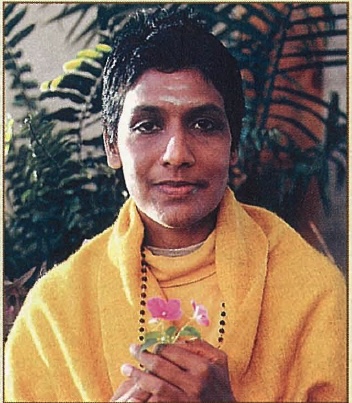BY BRAHMACHARINI MAYA TIWARI
Vedic seers considered milk to be the most sattvic (peace-producing) food for humankind. From this salubrious nourishment, choice butter, buttermilk, yogurt and ghee are made–that is, when the milk’s quality has remained pure and untampered with. Throughout the ages, milk has been used widely but not wisely. Because of the corruption prevalent in today’s animal husbandry, we are in danger of losing this sacred food of the earth. The cruel practices engaged in minding the animals, as well as the arsenal of poisons, chemicals and hormones which are used in their feed, all contribute to the misery of this beneficent animal, the impairment of her life-sustaining milk and the dimming of her natural Divine Light. But when butter, yogurt and ghee are made from milk produced by conscious organic dairy farmers, they are considered to be our most nourishing and healing foods. Among them, ghee stands out as the elixir for excellent health.
Sushruta, an ancient Ayurvedic seer, regarded ghee as an intelligence-building principle that fosters the body’s confidence and virility. Another ancient, Charaka, praises ghee’s ability to promote memory and immunity within the body. From the perspective of sadhana, spiritual discipline, ghee is associated with the body’s element of love. Its dominant action allows it to soothe our vital tissues. In Ayurveda, ghee is used as a primary vehicle for conveying herbal powders, essences and medicines into affected tissues because it penetrates them and enlivens vital tissue memory, soothing the body, mind and spirit of the patient.
Ghee also builds ojas, the body’s primordial immunological force, thereby reducing fatigue and stress while aiding the body to let go of its toxicity. Ghee may be used in cooking to reduce fatigue, emaciation, loss of appetite and stress from time to time throughout the year. Since the nature of ghee is usually peaceful and nourishing, it accommodates all metabolic types, restoring agni, digestive fire, and allowing the body to adjust to its newly attuned state of revitalization.
A few stories may best serve to illustrate the vast healing powers of ghee. Lynn had a severe strep infection in her throat. After one week of gargling with ghee, turmeric and warm water, her throat infection was gone. Eric, who had a chronic case of psoriasis, treated his condition by applying a poultice made from ghee and neem powder. One month later, Eric’s skin ailment was completely cured. Gita had suffered from years of nervous exhaustion, constipation and insomnia by the time she came to me for help. Along with dietary help, I recommended a simple tea made from hot water, ghee and triphala which she took for three months every evening after dinner. Her condition is now vastly improved.
For centuries ghee has been used as a remedy during the seasonal junctions when diseases tend to become more prevalent. At the onset of spring, a tablespoon of ghee may be taken with a few pinches of turmeric every morning for a week or so. Similarly, a tablespoon of ghee can be taken for a week at the commencement of summer with a teaspoon of unrefined brown sugar; at the onset of the rainy season combined with a few pinches of rock salt; at the arrival of autumn with a teaspoon of honey and as winter sets in, mixed with a teaspoon of molasses.
Ghee is made by boiling sweet butter, thereby ridding it of enzymes that could encourage bacteria. The quality of the ghee depends on the quality of the butter, as well as the means of making it and how it is stored. Stored in the right conditions, ghee not only lasts a long time, but its medicinal value increases as it ages. Used in small quantity, ghee is ideal for cooking as it does not burn unless heated excessively. It blends with food nutrients without losing its medicinal quality and therefore soothes and nourishes bodily constituents. Ghee is good for persons of all doshas (constitutional types) and is a specific for pitta. It requires no refrigeration, should be kept covered, away from direct sunlight or heat and protected from any contaminants.
Ceremony of ghee making: In times of yore, Vedic monks basked in the joyous ceremony of making ghee. This was held at purnima, the full moon. In meditative silence they would oversee the various stages of preparation. You, too, can approach ghee making as a sadhana. Proceed with a clean body and a calm mind. As the Vedic monks discovered, this sadhana can evoke the sattvic mind and brings forth wondrous healing energies in its practice. Be mindful of the aromas, sounds and presence of this delightful ceremony. For one pound of organic, sweet (unsalted) butter, you will need a heavy stainless steel saucepan, a stainless steel spoon and a glass storage jar, all sterilized in advance with boiling water. Melt the butter in the saucepan over low flame. Continue to heat until it boils gently and a buff-colored foam rises to the surface. Do not stir the melted butter or remove the foam (which would result in “clarified butter,” common in Western cooking). Allow the ghee to cook gently until the foam thickens and settles to the bottom of the pan as sediment. When the ghee turns a golden color and begins to boil silently, with only a trace of air bubbles on the surface, it is done. When it is cool, pour the liquid into the jar, making sure that the sediments remain on the bottom of the saucepan.


